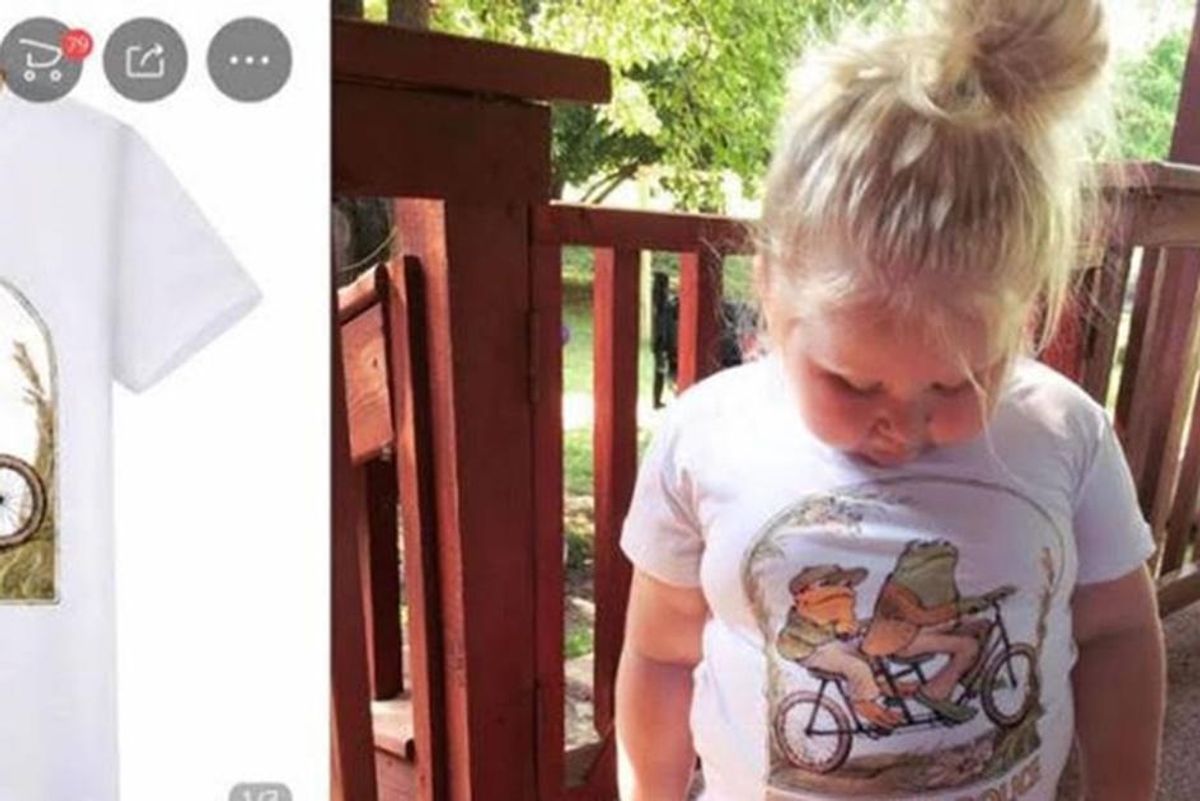Mom ordered an infant-sized Frog and Toad shirt from China. When it arrived, she ‘just screamed.’
That's not what anyone was expecting.

An unexpected statement on a Frog and Toad T-shirt.
Kelsey Dawn Williamson, 23, from Benton, Illinois has ordered over 50 shirts from AliExpress, an online retailer based out of Hangzhou, China. But when the Frog and Toad shirt she ordered on May 10 arrived, she "literally did not know how to react so I just took a few moments to stare at it and try to process."
The infant-sized shirt has a picture of the iconic reptiles from the children's book series riding old-fashioned bikes with "FUCK THE POLICE" written at the bottom.
Williamson posted a photo of her daughter Salem in the shirt on Facebook and it quickly went viral.
The shirt that was delivered looked exactly like the one in the online store, just without the caustic N.W.A. lyric.

Frog and Toad T-shirt that was advertised.
While it seems utterly bizarre that someone would create a shirt with "FUCK THE POLICE" written beneath a picture of Frog and Toad — a duo who've never been known to harbor ill will against law enforcement — there's a good reason.
Memes featuring Frog and Toad are so popular they have their own subreddit. The shirtmaker, who probably doesn't have a license to use Frog and Toad, must have got the photo from a Google search. The person who made the shirt was most likely Chinese and either didn't speak English or has a very poor eye for detail.
After Williamson received the shirt, she Facetimed her husband and they screamed together. "We both just lost it, dying of laughter," she told Buzzfeed. "All he could say was 'Oh shit.'"
"I've told [Salem], 'People really like your frog shirt!'" Williamson said. But she's not letting her child wear the offensive shirt to preschool. "It's going in her baby box so we can bring it up when she's older."
Unfortunately, the incident has been all laughs for Williamson. She's received messages from people who've fat-shamed her daughter.

A positive message.
via Kelsey Dawn Williamson / Facebook
"People were actually messaging me just to say mean things about her," she said. "A ton of people calling her fat, asking me what I feed her to make her so big, telling me the shirt I bought was too small."
But Williamson has remained strong and fought back against the shamers. She edited her post to address her daughter's weight but refuses to take it down. "SHE SEES SPECIALISTS FOR HER WEIGHT. SHE CANT HELP IT. I CANT HELP IT. MY HUSBAND CANT HELP IT. IT IS OUT OF OUR CONTROL. JUST LAUGH AT THE FUNNY SHIRT," Williamson wrote on Facebook.
That's right people, just laugh at the funny shirt, and stay out of people's business.

Frog says, “Come at me, bro!"
This article originally appeared on 06.01.19
- Ever wonder why politicians kiss babies? The answer is weirder ... ›
- People are loving this hilarious viral post about a dad bottle-feeding ... ›
- This son sent his mom a life-size cutout of himself. She got the last laugh. - Upworthy ›
- Mom rescues son's pet frog after it gets stuck in the wall - Upworthy ›
- Sweet 6-year-old designs custom 'I'll be your friend' t-shirt for his first day of school - Upworthy ›







 Rihanna Nails GIF
Rihanna Nails GIF

 Good luck trying to catch a gazelle.
Good luck trying to catch a gazelle. Chickens will eat just about anything.
Chickens will eat just about anything. There's actually a big difference between horses and zebras besides just the stripes.
There's actually a big difference between horses and zebras besides just the stripes. Stop Right There The End GIF by Freeform
Stop Right There The End GIF by Freeform